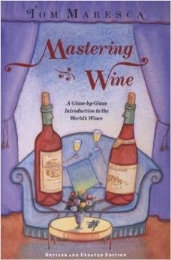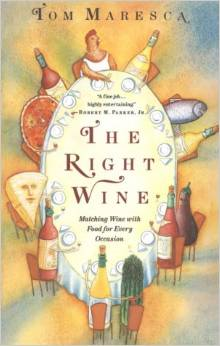Rome has many charms, but an abundance of great wine is not one of them. Once upon a time – my brother and I first visited Rome in 1964, so this is history, not fable – your wine options in most trattorias were rosso or bianco, both vino sfuso – that is, drawn from a barrel or demijohn, not from a bottle. The red was usually some form of Chianti and the white was almost always brown (from rapid oxidation, then a serious problem for Italian white wine) and usually some form of Frascati.
Much has changed for the better since then. The white wine now really is white, and almost invariably young and fresh and charming. And although now-much-improved Frascati is still ubiquitous, most trattorias – and certainly anything calling itself a ristorante – will also offer several other options from other parts of Italy. Red wine lists seem to have grown even more, now providing good choices of many varieties from all over Italy – including, at long last, a growing representation of indigenous Lazio (Rome’s region) bottlings.

The selection at the Cul de Sac wine bar
Nevertheless, really deep wine lists are still few and far between, and the lover of older wines has to search pretty hard to find a mature bottle of almost anything. So when Diane and I went recently to Rome for a week of pure vacation – I promised no winery visits, no tasting sessions – we contented ourselves mostly with the kinds of wines that provide plenty of pleasure without needing long cellaring. Rome offered many of those.
We tried many young Frascatis, of course, and all were genuinely charming, with the light floral/mineral nose and palate characteristic of the breed. One of the most interesting, which we tasted at the Trimani wine bar, was in fact not a Frascati but an IGT Lazio wine from Casale  Certosa. It was a 2014 (almost all the whites were 2014, a very few 2015) Alborea, a rich, lightly golden wine of greater than usual intensity. It was blended from Grecchetto and Malvasia Puntinata, the latter grape a Lazio specialty and usually an important component of Frascati. I don’t think this wine is imported to the US. One of the advantages (and limitations, from a wine journalist’s point of view) of drinking in Rome is the opportunity to taste wines, both kinds and producers, that don’t always make it across the pond.
Certosa. It was a 2014 (almost all the whites were 2014, a very few 2015) Alborea, a rich, lightly golden wine of greater than usual intensity. It was blended from Grecchetto and Malvasia Puntinata, the latter grape a Lazio specialty and usually an important component of Frascati. I don’t think this wine is imported to the US. One of the advantages (and limitations, from a wine journalist’s point of view) of drinking in Rome is the opportunity to taste wines, both kinds and producers, that don’t always make it across the pond.
 Other whites that we enjoyed included a lovely light, refreshing 2015 Pigato from Liguria (Pigato is the regional name for Vermentino), a characteristic Falanghina from Benevento by Vinicola del Sannio, and a 2015 Mastroberardino Fiano – the latter, of course, in a distinctly different weight and quality class from the lighter more apéritif style of the preceding wines.
Other whites that we enjoyed included a lovely light, refreshing 2015 Pigato from Liguria (Pigato is the regional name for Vermentino), a characteristic Falanghina from Benevento by Vinicola del Sannio, and a 2015 Mastroberardino Fiano – the latter, of course, in a distinctly different weight and quality class from the lighter more apéritif style of the preceding wines.
BTW, we tasted a lot of these wines by the glass at two of our favorite places in Rome to get a light lunch: the wine bars Cul de Sac and Angolo Divino. Both offer a splendid array of cheeses and salume and light dishes, though at both you can order more substantially if you wish. Either way, you can taste glasses of as many wines as you have time and capacity for, from a well-chosen list, with many, many more wines available by the bottle, should you opt to make an afternoon of it.
 Everywhere we dined in Rome, our choices for red wine seemed much richer than for whites. The red wine situation, it’s fair to say, is happily more complex than the white. We drank a number of familiar standbys, of course – a 2009 Mastroberardino Radici Taurasi, for instance, though that turned out to be infanticide: That bottle had years of development before it.
Everywhere we dined in Rome, our choices for red wine seemed much richer than for whites. The red wine situation, it’s fair to say, is happily more complex than the white. We drank a number of familiar standbys, of course – a 2009 Mastroberardino Radici Taurasi, for instance, though that turned out to be infanticide: That bottle had years of development before it.
 We also drank a 2007 Montevetrano, which was a lovely representative of this unusual (for Campania) blend of Cabernet, Merlot, and Aglianico. It was evolving beautifully, but it too had years of maturation to go. The slightly disappointing restaurant at which we drank it provided a wonderful instance of just how thin wine knowledge is even in seemingly better places. When I asked for a bottle of Montevetrano, our waiter didn’t recognize the name, and didn’t know it was on his wine list. I pointed it out and explained it was a Campanian wine. He looked and said “No; this says it’s from Salerno.” – He didn’t even know Salerno is in Campania. After that he disappeared for a while and, apparently after consultation with someone more knowledgeable, returned bearing the bottle and self-importantly informed me that this was one of Italy’s greatest wines – which, of course, was why I had ordered it in the first place.
We also drank a 2007 Montevetrano, which was a lovely representative of this unusual (for Campania) blend of Cabernet, Merlot, and Aglianico. It was evolving beautifully, but it too had years of maturation to go. The slightly disappointing restaurant at which we drank it provided a wonderful instance of just how thin wine knowledge is even in seemingly better places. When I asked for a bottle of Montevetrano, our waiter didn’t recognize the name, and didn’t know it was on his wine list. I pointed it out and explained it was a Campanian wine. He looked and said “No; this says it’s from Salerno.” – He didn’t even know Salerno is in Campania. After that he disappeared for a while and, apparently after consultation with someone more knowledgeable, returned bearing the bottle and self-importantly informed me that this was one of Italy’s greatest wines – which, of course, was why I had ordered it in the first place.
Most of the reds we enjoyed were younger than those two, however. One stand-out was a 2013 Villa Simone Cesanese – a native Lazio grape – that was soft, fresh, and fruity, with some real depth and excellent varietal character. We liked that so much we ordered a second bottle and made that dinner last.  Another very distinctive regional wine, this one from the Amalfi coast, was 2012 Quattro Spine Costa d’Amalfi Rosso from Tenuta San Francesco. Again, I don’t know if this wine is available in the US, but it’s definitely worth seeking out, whether at home or abroad. It was an intriguing blend of Aglianico, Tintore, and Piedirosso, very dark, rich and deep, powerful and elegant. I’d love the chance to taste an older bottle.
Another very distinctive regional wine, this one from the Amalfi coast, was 2012 Quattro Spine Costa d’Amalfi Rosso from Tenuta San Francesco. Again, I don’t know if this wine is available in the US, but it’s definitely worth seeking out, whether at home or abroad. It was an intriguing blend of Aglianico, Tintore, and Piedirosso, very dark, rich and deep, powerful and elegant. I’d love the chance to taste an older bottle.
 The oldest bottles we had on this trip we enjoyed at Fortunato del Pantheon, and at Checchino dal 1887. At the former, our waiter walked me into the attached enoteca (a new development since we’d last dined there), where the sommelier unearthed a 2007 (not so old, but hey! we’re in Rome) bottle of Maurizio Zanella Rosso del Sebino. A blend of 50% Cabernet sauvignon, 25% Merlot, and 25% Cabernet franc, and almost inky dark, it was big, round, and soft, with very soft tannins, and tasted of mature black fruits. It proved an excellent companion to our dishes of tagliarini with white and black truffles.
The oldest bottles we had on this trip we enjoyed at Fortunato del Pantheon, and at Checchino dal 1887. At the former, our waiter walked me into the attached enoteca (a new development since we’d last dined there), where the sommelier unearthed a 2007 (not so old, but hey! we’re in Rome) bottle of Maurizio Zanella Rosso del Sebino. A blend of 50% Cabernet sauvignon, 25% Merlot, and 25% Cabernet franc, and almost inky dark, it was big, round, and soft, with very soft tannins, and tasted of mature black fruits. It proved an excellent companion to our dishes of tagliarini with white and black truffles.
 By far the most interesting red wine of our trip was the sommelier’s suggestion at Checchino. This was no surprise, because it has one of the best wine lists in Rome, and when asked for a more mature wine, Francesco Mariani (one of the brothers who own Checchino) suggested a 1983 Colle Picchioni Rosso (as it turned out, the same wine he had served my friend and colleague Charles Scicolone just a week before ).
By far the most interesting red wine of our trip was the sommelier’s suggestion at Checchino. This was no surprise, because it has one of the best wine lists in Rome, and when asked for a more mature wine, Francesco Mariani (one of the brothers who own Checchino) suggested a 1983 Colle Picchioni Rosso (as it turned out, the same wine he had served my friend and colleague Charles Scicolone just a week before ).
This is a Lazio wine, grown and vinified not many miles outside of Rome. It’s probably – firm data is hard to come by – a blend of the native Cesanese with Merlot and maybe Sangiovese, maybe Aglianico, maybe Cabernet; in 1983 things were still pretty loose in Lazio (Charles thinks it’s all international varieties; I’m not so sure). Francesco knows his stock: Whatever grapes are in it, this wine turned out to be perfect choice with our food, initially delicate but growing in strength as it opened. Pale garnet with an orange edge, it looked and smelled like a mature wine, the nose almost delicate. On the palate, very balanced, and even lively, with still fresh fruit suggesting dark berries that lingered into the elegant finish: a really lovely bottle of wine.
Diane has blogged about the meals we ate in Rome, so the palatally curious can see what kinds of food went with the wines I’ve been talking about by clicking here.
One final word: None of these wines was expensive, especially not by New York standards. The older wines cost far less than new vintages sell for at retail here, which gives you some sense of just how outrageous the price-gouging is in American restaurants. And in even the busiest, most touristed Roman restaurants, the sound levels were such that the two of us were able to speak in normal tones, which gives you some idea of what a deliberately manipulated environment most American restaurants are providing. As one of my old teachers used to say, verb. sap. sat. Save your money, and dine out in Europe.
Read Full Post »








































